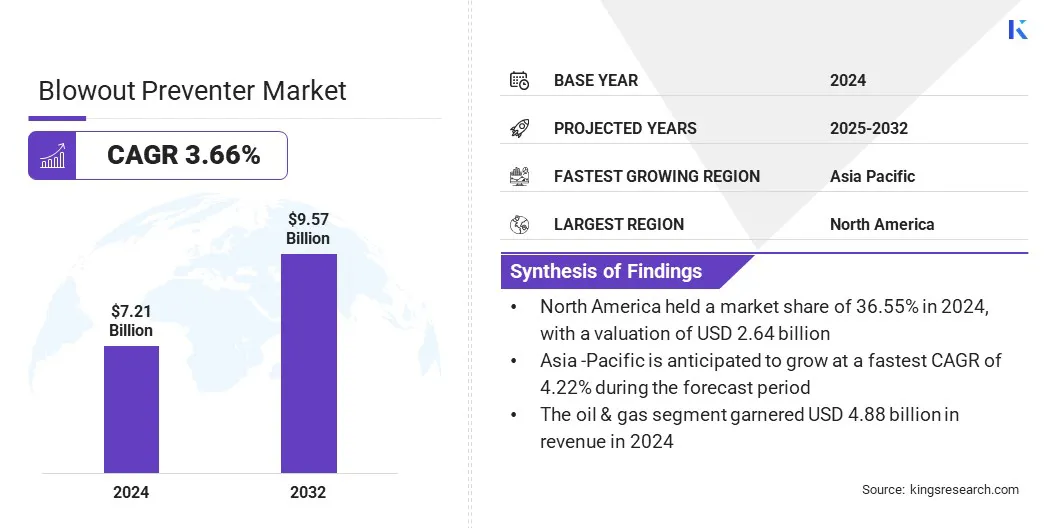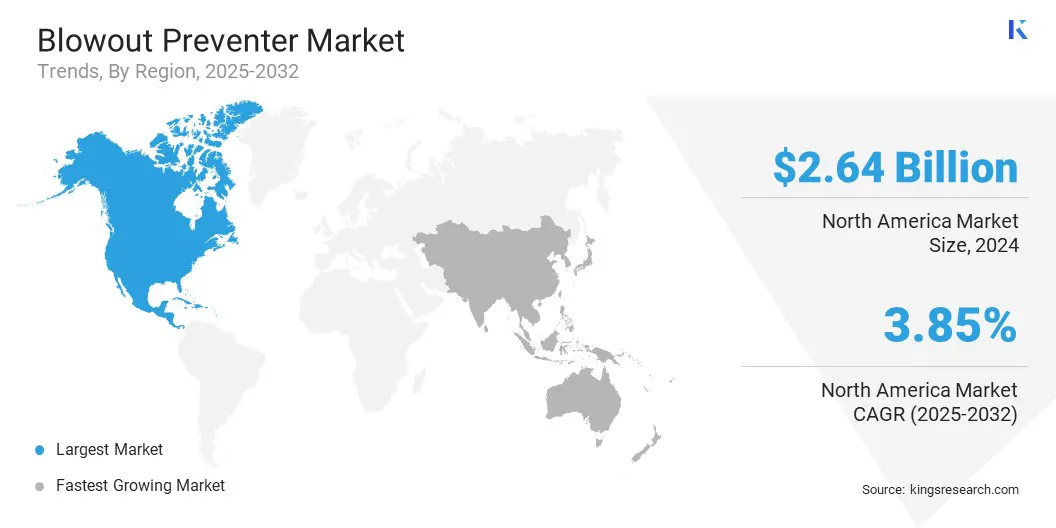Market Definition
A blowout preventer (BOP) is a safety system that seals, controls, and monitors oil and gas wells to prevent blowouts and ensure operational safety. The market encompasses the manufacturing, distribution, and servicing of ram-type and annular BOP systems, control systems, and related components that are used in onshore and offshore drilling activities.
Blowout Preventer Market Overview
The global blowout preventer market size was valued at USD 7.21 billion in 2024 and is projected to grow from USD 7.44 billion in 2025 to USD 9.57 billion by 2032, exhibiting a CAGR of 3.66% over the forecast period.
Market growth is driven by rising global demand for oil and gas, which is encouraging expanded exploration and production activities. Increasing exploration activities in deepwater and ultra‑deepwater fields are further boosting the demand for advanced blowout preventer systems to ensure efficient and reliable drilling operations.
Key Highlights:
- The blowout preventer industry size was recorded at USD 7.21 billion in 2024.
- The market is projected to grow at a CAGR of 3.66% from 2025 to 2032.
- North America held a share of 36.55% in 2024, valued at USD 2.64 billion.
- The ram blowout preventer segment garnered USD 3.92 billion in revenue in 2024.
- The offshore segment is expected to reach USD 5.73 billion by 2032.
- The geothermal segment is anticipated to witness the fastest CAGR of 4.27% over the forecast period.
- Asia Pacific is anticipated to grow at a CAGR of 4.22% over the forecast period.
Major companies operating in the blowout preventer market are Schlumberger Limited, Baker Hughes Company, NOV, Weatherford, TechnipFMC plc, Halliburton Energy Services, Inc, Control Flow, Inc, BOP Products, LLC, WOM Inc, Kerui Oil & Gas, CANSCO Control Technology Inc, Satyam Oilfield Equipments and Services, Oceaneering International, Inc, AXON Pressure Products, Inc, and UZTEL S.A.

The rising upstream oil and gas costs are accelerating the adoption of advanced blowout preventer systems to improve drilling efficiency and ensure operational safety. Additionally, growing emphasis by operators on reducing downtime and preventing costly incidents is driving investments in reliable well control solutions, thereby supporting the growth of the market.
- The International Energy Agency (IEA) projects that upstream oil and gas costs will rise by approximately 3% in 2025.
Market Driver
Rising Global Demand for Oil and Gas
A key factor propelling the growth of the blowout preventer market is the rising global demand for oil and gas, which is encouraging increased drilling and exploration activities worldwide.
Growing energy needs, driven by economic growth and industrial expansion are prompting operators to expand offshore and onshore production. This is leading to higher adoption of blowout preventers to ensure well control, operational safety, and regulatory compliance for onshore and offshore drilling projects.
- S. Energy Information Administration (EIA) reported that crude oil production in the Federal Offshore Gulf of Mexico is forecast to average 1.80 million barrels per day (b/d) in 2025 and 1.81 million b/d in 2026, up from 1.77 million b/d in 2024.
Market Challenge
High Initial Costs of Advanced BOP Systems
A key challenge impeding the growth of the blowout preventer market is the high initial cost of advanced BOP systems. These systems incorporate complex hydraulic mechanisms and digital control technologies that significantly increase capital expenditure. These high upfront costs create entry barriers and slow the broader adoption of advanced BOP solutions.
To address this challenge, market players are offering flexible financing options, leasing models, and service-based contracts, as well as investing in research and development to reduce manufacturing costs and improve operational efficiency. These strategies aim to make advanced BOP systems more accessible to oil and gas operators, particularly in emerging regions.
Market Trend
Introduction of Next-Generation Blowout Preventer (BOP) Technologies
A key trend shaping the blowout preventer market is the introduction of next-generation BOP technologies. Manufacturers are launching innovations such as automated locking mechanisms, boltless bonnet designs, and higher pressure-rated BOPs that improve operational efficiency, safety, and reliability in well control operations.
These advancements reduce maintenance time, minimize downtime, and help operators comply with safety regulations during complex offshore and onshore drilling projects.
- In June 2024, INTLEF Oil and Gas Group launched the QL-type boltless bonnet hydraulic locking blowout preventer to enhance safety and efficiency in drilling operations. This enables rapid bonnet opening and closing without removing bolts and incorporates a hydraulic automatic locking structure for reliable operation.
Blowout Preventer Market Report Snapshot
|
Segmentation
|
Details
|
|
By Type
|
Ram Blowout Preventer, Annular Blowout Preventer, Hybrid Blowout Preventer
|
|
By Application
|
Onshore, Offshore
|
|
By End-Use Industry
|
Oil & Gas, Geothermal, Mining
|
|
By Region
|
North America: U.S., Canada, Mexico
|
|
Europe: France, UK, Spain, Germany, Italy, Russia, Rest of Europe
|
|
Asia-Pacific: China, Japan, India, Australia, ASEAN, South Korea, Rest of Asia-Pacific
|
|
Middle East & Africa: Turkey, U.A.E., Saudi Arabia, South Africa, Rest of Middle East & Africa
|
|
South America: Brazil, Argentina, Rest of South America
|
Market Segmentation:
- By Type (Ram Blowout Preventer, Annular Blowout Preventer, and Hybrid Blowout Preventer): The ram blowout preventer segment earned USD 3.92 billion in 2024 due to its high reliability and effectiveness in controlling high‑pressure wells in deep-water and ultra‑deepwater drilling.
- By Application (Onshore and Offshore): The offshore segment held 56.77% of the market in 2024, due to increasing deep-water exploration activities and rising investments in offshore oil and gas projects.
- By End-Use Industry (Oil & Gas, Geothermal, and Mining): The oil & gas segment is projected to reach USD 6.37 billion by 2032, owing to growing global energy demand and expansion of exploration and production activities.
Blowout Preventer Market Regional Analysis
Based on region, the market has been classified into North America, Europe, Asia Pacific, Middle East & Africa, and South America.

North America blowout preventer market share stood at 36.55% in 2024 in the global market, valued at USD 2.64 billion. This dominance is driven by rising demand for oil and gas, which is encouraging exploration and production activities across onshore and offshore fields in this region. Expanding investments by major energy companies in deepwater drilling are driving the need for advanced blowout preventer systems that ensure operational safety and compliance.
Stringent safety regulations by the U.S. Bureau of Safety and Environmental Enforcement (BSEE) and Canada’s National Energy Board are compelling operators to adopt robust well control solutions. Moreover, regional players are pursuing strategic fleet expansions to strengthen capabilities and meet the growing demand for safe and efficient drilling operations across region.
- In September 2024, Noble completed a USD 1.6 billion acquisition of Diamond Offshore Drilling, adding 10 floaters to its fleet. The deal creates a fleet of seventh‑generation dual‑blowout preventer drillships, expanding Noble’s offshore drilling capacity.
Asia Pacific is set to grow at a robust CAGR of 4.22% over the forecast period. This growth is due to the region’s rapid expansion in offshore oil and gas exploration activities. Growing energy demand from emerging economies, including China, India, and Southeast Asian nations is prompting large‑scale drilling activities.
Government initiatives such as China’s 14th Five‑Year Plan for energy development, India’s Hydrocarbon Exploration and Licensing Policy (HELP) to strengthen energy security and investments in offshore infrastructure are further fueling demand for advanced blowout preventer systems. Moreover, regional players are innovating in BOP design to improve efficiency, safety, and operational reliability, thereby fueling market growth.
- In April 2024, Oil and Natural Gas Corporation (ONGC) announced plans to begin drilling a geothermal project in Ladakh, India. It includes two wells of 1,000 m depth each and the use of advanced equipment, including a blowout preventer.
Regulatory Frameworks
- In the U.S., the Bureau of Safety and Environmental Enforcement (BSEE) regulates offshore oil and gas operations, including blowout preventer systems. BSEE oversees design approvals, safety standards, equipment testing, and maintenance protocols. It enforces compliance through inspections to prevent blowouts, protect workers, and minimize environmental risks in offshore drilling.
- In the UK, the Offshore Safety Directive Regulator (OSDR) oversees offshore oil and gas safety, including blowout preventer systems. OSDR enforces equipment certification, operational safety, and maintenance requirements, audits compliance, and ensures high safety standards to prevent blowouts, protect workers, and safeguard the marine environment.
- In China, the Ministry of Emergency Management (MEM) oversees safety in oil and gas exploration, including blowout preventers. MEM regulates manufacturing standards and emergency response planning to ensure compliance with safety codes and to protect workers and the environment in onshore and offshore drilling.
- In India, the Directorate General of Mines Safety (DGMS) regulates drilling safety, including blowout preventers. DGMS sets equipment standards, oversees installation and testing protocols, and enforces compliance with well control regulations to ensure safe drilling practices and to protect personnel, communities, and the environment.
Competitive Landscape
Major players in the blowout preventer industry are focusing on advancing product design and manufacturing to enhance safety, reliability, and efficiency in well control operations. They are investing in research and development to introduce innovative technologies such as automated locking systems and boltless bonnet designs that reduce maintenance time and improve operational performance.
Companies are expanding their service capabilities and geographical presence by forming strategic partnerships and acquisitions to strengthen their market position and meet growing demand for advanced well control solutions. Additionally, market players are enhancing their portfolios with advanced data analytics and hydraulic completion solutions to provide integrated well intervention services.
- In February 2025, Enersol acquired a 95% stake in Deep Well Services (DWS) to strengthen its well intervention capabilities. The acquisition enables Enersol to leverage DWS’s patented hydraulic completion units, data analytics, and certified blowout preventers.
Top Key Companies in Blowout Preventer Market:
- Schlumberger Limited
- Baker Hughes Company
- NOV
- Weatherford
- TechnipFMC plc
- Halliburton Energy Services, Inc
- Control Flow, Inc
- BOP Products, LLC
- WOM Inc
- Kerui Oil & Gas
- CANSCO Control Technology Inc
- Satyam Oilfield Equipments and Services
- Oceaneering International, Inc
- AXON Pressure Products, Inc
- UZTEL S.A.
Recent Developments
- In October 2024, Axis Energy Services and Brigade Energy Services merged to form the largest well servicing company in the U.S. The merger creates an organization with over 1,700 employees, more than 200 active workover rigs, and a fleet that includes blowout preventers and pipe handlers, enhancing operational capacity.


